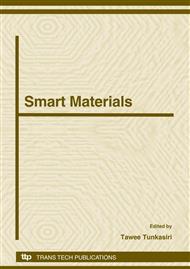p.513
p.517
p.521
p.525
p.529
p.533
p.537
p.541
p.545
Improvement of Mesopore Structure of Resorcinol and Formaldehyde Carbon Cryogels by Acid Solution
Abstract:
Resorcinol and formaldehyde (RF) carbon cryogels are prepared by sol-gel polycondensation by using sodium carbonate (C) as a catalyst with water (W) as solvent, immersed in acid solution, hydrochloric acid (HCl), dried by freeze-drying technique and then carbonized under inert atmosphere, respectively. Compared with their carbon precursors, both Vmes and mesopore size distributions of all carbon cryogels can be developed since the pore shrinkage is the crucial role in the change of pore structure of carbon gels. HCl may promote the strength of small pore structure and increase the pore shrinkage of large pore structure. Consequently, the treatment of HCl does not only enhance the partial collapse of large pore structure, the treatment also increases the strength of small pore structure to inhibit the shrinkage of this structure during carbonization as well.
Info:
Periodical:
Pages:
529-532
Citation:
Online since:
August 2008
Keywords:
Price:
Сopyright:
© 2008 Trans Tech Publications Ltd. All Rights Reserved
Share:
Citation:


